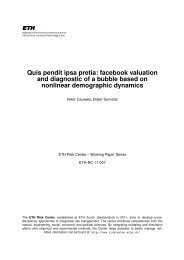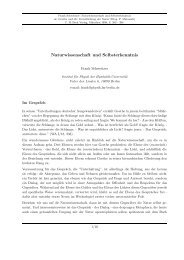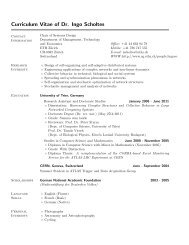Using Laboratory Experiments to Study Law and Crime - Chair of ...
Using Laboratory Experiments to Study Law and Crime - Chair of ...
Using Laboratory Experiments to Study Law and Crime - Chair of ...
Create successful ePaper yourself
Turn your PDF publications into a flip-book with our unique Google optimized e-Paper software.
college students differ from felons in theoretically relevant ways <strong>and</strong> that those differencesinteract with the causal fac<strong>to</strong>r <strong>of</strong> interest. For example, felons are socially stigmatized in waysthat college students are not. Perhaps disenfranchisement has an effect for stigmatized people butnot for others. If so, then we need <strong>to</strong> modify our theory <strong>to</strong> include stigma, <strong>and</strong> conduct a newexperiment <strong>to</strong> test this possibility. We might also conduct an experiment with convicted felons<strong>and</strong> see if the experimental results with felons are consistent with patterns observed in the field.The result <strong>of</strong> these processes is that our knowledge grows.In many instances, however, the characteristics <strong>of</strong> subjects do not interact with thetheoretical causal fac<strong>to</strong>rs <strong>of</strong> interest. Medical researchers use mice (despite their obviousdifferences from humans) because they are similar <strong>to</strong> human beings in theoretically relevantways (Campbell <strong>and</strong> Campbell, 2006). They can therefore help scientists underst<strong>and</strong> themechanisms that contribute <strong>to</strong> diseases such as cancer. Similarly, experiments with collegestudents can help us underst<strong>and</strong> mechanisms that lead <strong>to</strong> deviant behavior. As long as collegestudent subjects are similar <strong>to</strong> others in theoretically relevant ways, we would expect similarpatterns <strong>of</strong> responses <strong>to</strong> the experimental manipulations. Subjects who are different from innercity residents, high-school drop-outs, or white collar criminals may engage in more or less <strong>of</strong> thebehavior <strong>to</strong> be explained. Their responses <strong>to</strong> the experimental manipulations should reveal thesame patterns, however. In other words, as long as the characteristics <strong>of</strong> the subject do notinteract with the causal fac<strong>to</strong>r <strong>of</strong> interest, we might see higher or lower overall levels <strong>of</strong> theoutcome behavior depending on the subject pool, but the effects <strong>of</strong> the experimentalmanipulations would be observed regardless <strong>of</strong> the subjects.TRIVIALITYOne criticism <strong>of</strong> labora<strong>to</strong>ry experiments is that they can only examine trivial behaviorsthat we do not care about – like stealing points from another subject or cheating (for example <strong>of</strong>some experimental studies <strong>of</strong> crime see Fetchenhauer, Simon, <strong>and</strong> Fetchenhauer, 2008; Kalkh<strong>of</strong>f7







